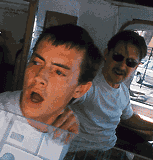Putnam did have to make do, however, with a small donated lighting package. "We had a few HMIs, two 2500 Fresnels, and a 4K Par for a couple of nights," says the cameraman. "But for the most part we used a small tungsten package, and we always had to think of the simplest way to shoot things."
Interesting camera blocking came to bear during a performance by jazz veteran Jimmy Scott as he crooned "Sometimes I Feel Like a Motherless Child." Goldberg, a big fan of Scott's, wrote the scene hoping for the best, and was pleasantly surprised when the septuagenarian Scott agreed to come to L.A. He agreed to sing the song twice, live, so Putnam couldn't afford to make any errors while capturing the footage. The cinematographer explains, "We turned the stage sideways, and then added lights in the back to make the setting more dramatic. We had two cameras: we set up one as a stationary 'safety' unit, covering the shot with a wide-angle lens, and kept the other camera moving on a dolly. We listened to the music and tried to pace the tracking."
The film's most elaborate sequence is an argument between Jim and Ilsa, which occurs in the pouring rain among the columns on Venice, California's Windward Avenue, a location made famous in Orson Welles' Touch of Evil. "We had a Highlight, which is a truck with two 12Ks on it," says Putnam. "In the script, the scene takes place in a heavy downpour, which is one of things that originally excited me. However, the reality of having two actors in the rain for eight hours trying to do this emotional scene made us rethink our approach. We decided to put them under the roof over the sidewalk to give them some shelter."
Creating the mood-enhancing rainfall was also problematic. "In the tight shots, it was no problem, because we had a rain tower. In the opening shot, though, the characters walk across the street. We decided to have it start raining once the sequence got going." Putnam continues, "We had three cameras that night one on a Louma Crane, one on a Steadicam, and another on a dolly or on sticks. We had so much to do; it was summer, so the night was short, and we knew that if we had to keep switching the camera to different rigs, we'd never get through the sequence."
The night scenes were also tough because of the stock Putnam was using. "You don't have much choice when you shoot in black-and-white," he says. "With Kodak, you either have the 50 ASA or the 200 ASA, so that was the hardest thing. Shooting color negative on a low-budget film, you're usually on 5298 or 96 at an ASA of 500, but we were shooting with 5222 and then 5231 for the day exteriors so we usually only had an ASA of 200. That meant we had to get enough light out there at night to get a decent stop. One of my biggest concerns was giving the first A.C. enough room to work; we were using MKII Ultra-Speed primes, but I didn't want to be shooting a lot of things at T1.3 because even the best assistant needs some leeway. We usually shot at around 2.8. I'd look at the A.C., Bobby Truitt, who did an amazing job, and say, 'Can I open up a third of a stop on this one?' and he'd either say yes or no. We had a great relationship that way."
One of the film's most visually striking scenes takes place in daylight beneath the Santa Monica Pier, where the friends cavort together. The dark posts and the actors' black clothes contrast beautifully with the bright, misty light beyond the pier. Putnam explains how he got these challenging shots: "We didn't have any lights, so we used reflectors, and the sequence is really just a result of the [exposure] difference: it was about a T3.2 outside, and under the pier it was a 2.8. We really had to stretch the limits, because outside we had this glowing, unreal light, and what we wanted was the contrast with the sky and the water in the background." Putnam certainly achieved that contrast the ethereal scene is one of the film's most stunning moments, and makes a more than convincing case for the efficacy, and beauty, of black-and-white stocks.
